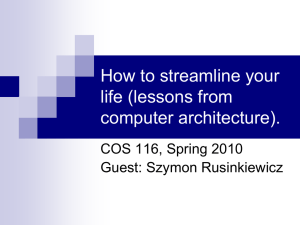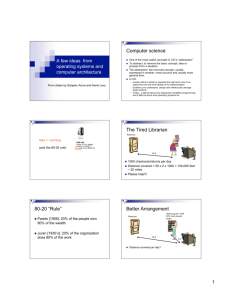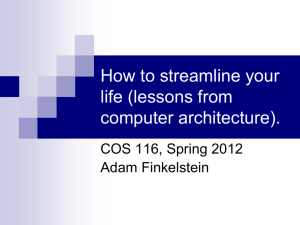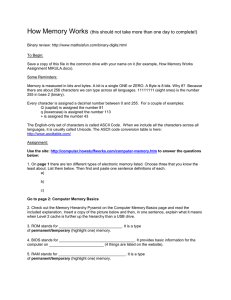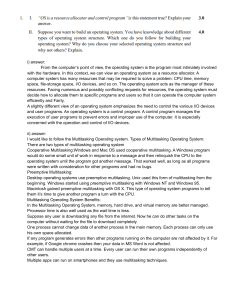How to streamline your life (lessons from computer architecture). COS 116
advertisement
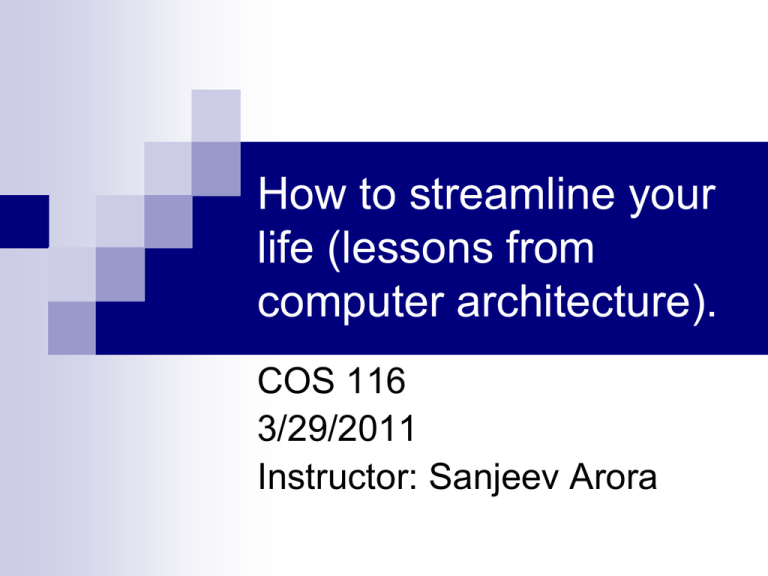
How to streamline your life (lessons from computer architecture). COS 116 3/29/2011 Instructor: Sanjeev Arora Lesson 1: Caching (and the 80-20 rule) (Aside: 1066 FSB = Front side bus operates at 1066Mhz (upper limit on the speed of data communication of CPU with rest of computer) Quad-core: Processor with 4 separate built-in processors ) The Tired Librarian Reserves 50 ft 1000 checkouts/returns per day Distance covered = 50 x 2 x 1000 = 100,000 feet ~ 20 miles Please help!!! 80-20 “Rule” Pareto [1906]: 20% of the people own 80% of the wealth Juran [1930’s]: 20% of the organization does 80% of the work Better Arrangement “Most popular” shelf: 20% most popular books Reserves 50 ft 5 ft Distance covered per day? Even better arrangement? “Most popular” shelf: 20% most popular books Reserves Top 4% 50 ft Distance covered per day? 5 ft Discussion Time Is the librarian’s problem solved? How to predict the 20% most popular books for next day? Suggestions? How to predict the 20% most popular books for next day? In general, no easy solution In practice, use rules of thumb “Least Recently Used”. When you need to create space on the desk (or shelf), move out the book that was used least recently Many others (LRU is computationally expensive) Example: Connection to Computer Organization Speed vs cost of various memories Cost: $ / GB Speed: GB/s Hard drive 0.05 0.3 RAM 50 1.5 40000 15 On-chip memory for CPU (L2 Cache) Computer Librarian arrangement Reserves Disk “Most popular” shelf: 20% most popular books Memory CPU Often, today’s computers have even more levels of caching Top 4% Cache Question How does the same program (.exe file) run on different PCs with different memory configurations? Answer: “Virtual Memory” All programs live a fiction: allowed to pretend it has 264 bytes of memory Illusion is preserved by hardware Goodbye Lenin "The German Democratic Republic lives on – in 79 m²!" (Die DDR lebt weiter – auf 79 qm!) Virtual Memory Program’s view: Lec15.ppt Powerpoint Memory: Address 0 P ≠ NP.ppt Underlying truth: Address 264 - 1 Discussion Time Hard drive RAM Cost: $ Speed: / GB GB/s 0.05 0.3 50 5 Assuming the 80-20 rule, what is the maximum data transfer speed the CPU can expect to see? How does your answer change if cost is no object? What determines RAM size? Divide into groups of 3 and hand in your calculations & thoughts. Moral Performance: Speed is close to that of fastest memory (cache) Overall capacity is that of largest memory (disk) Lesson 2: Multitasking “The Multitasking Generation” An Evening’s Tasks for a GenM’er Homework Listen to music Instant Messaging Call Mom (goes to bed by 11 PM!) Answer phone Read a bit more of Joyce’s Ulysses Watch the Daily Show How do you do it all? Can the brain do multiple things at a single instant? Tasks done by my PC last night Word processing Play CD Download news updates Download email Run clock Hidden tasks: handle network traffic, manage disk and RAM traffic, scheduler, etc. Managed by “Operating System” (WinXP, Linux, MacOS, etc.) Scheduler’s objectives Fairness Timeliness Critical tasks processed promptly Low overhead Discussion Time How can one achieve these (often conflicting) goals? Multitasking versus Parallel Processing Multitasking: A single CPU handles many tasks by switching rapidly among them. (e.g., all Wintel machines since early 1990s; all Unix machines since the 1970s) Parallel Processing: Multiple CPUs that do the work of a single CPU. (But, 4 CPUs do not necessarily mean 4x speed.) The Legal View…. One main point studied by the judge: What is an OS? Software that always runs on the computer in the background and acts as intermediary between the underlying hardware and all software applications
